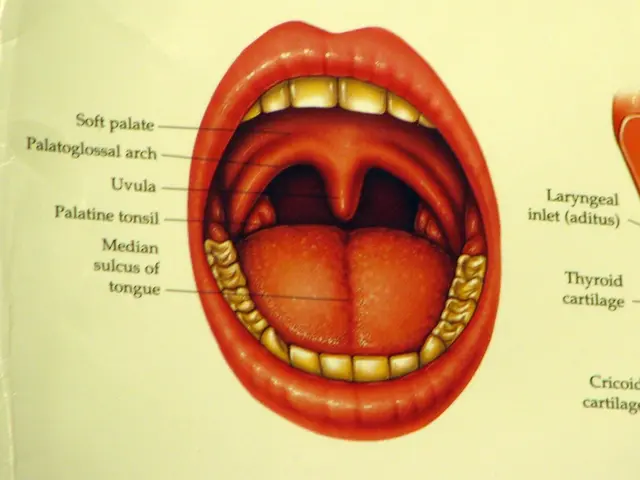Connection and Risk Factors Between Breast and Ovarian Cancer
Breast cancer and ovarian cancer, two formidable foes in the realm of female health, share a strong link established primarily through genetic factors, especially the BRCA1 and BRCA2 genes. Why? Because, as they say in the streets, "what affects one, can potentially affect the other."
Yes, you read that right! If you've had breast cancer, be vigilant – set your radar for ovarian cancer too. The risk is particularly elevated if your breast cancer stems from genetic mutations in BRCA1 or BRCA2. Research has it that individuals with such mutations have approximately double the chance of developing subsequent primary ovarian cancer.
On the flip side, those with ovarian cancer, though the risk ratio is slightly lower (1.6 times), should keep breast cancer in their radar too, with the risk fluctuating depending on the time gap since the first cancer diagnosis.
Similar genetic mutations don't just play foul with the ovaries; they can tango with the breasts as well.
Now, let's talk about other shared risk factors. BRCA1 and BRCA2 mutations stand out as the most significant, with roughly a third of families with ovarian and breast cancer carrying BRCA1 gene mutations, and around 20% harboring BRCA2 mutations.
Additional risk factors include a family history of either cancer, older age (ovarian cancers typically occur over 40 and breast cancers after 55), overweight/obesity, having a first child after 30, never giving birth, not breastfeeding, and hormone therapy after menopause.
Can people influence these risks? That's a resounding yes! Modifiable risk factors like achieving and maintaining a moderate weight, regular exercise, limiting alcohol intake, and discussing contraception options with a doctor can help reduce the risk of breast and ovarian cancer.
It's all about being proactive and seizing the opportunities presented to reduce risk and take control of your health. Genetic testing for BRCA1, BRCA2, and other relevant mutations, as well as regular screenings guided by healthcare professionals, can pave the way for informed decisions and effective preventive measures.
For those carrying genetic mutations, prophylactic surgeries could be considered to prevent the occurrence or spread of cancer, but that's a decision best made between you and your healthcare team.
Remember, not all risks are changeable, so focus on what you can manage. And always, early detection and prompt treatment are the keys to a brighter future.
Check in with your doctor if you experience signs and symptoms of breast or ovarian cancer, especially with a personal or family history of these diseases. Staying informed and vigilant is crucial in the battle against breast and ovarian cancers.
For more evidence-based information and resources, hop on over to our dedicated hub. Now, keep reading, because knowledge is power!
Oh, and here's a heads-up: if you have ovarian cancer, it might be wise to gear up for potential battles with bladder, bile duct, colorectal, acute leukemia, or melanoma of the eye as well.
Lastly, it's important to note that breast cancer can metastasize, or spread, to the ovaries, although it's relatively rare. This risk may be heightened in hormone receptor-positive breast cancers or for individuals carrying BRCA mutations.
In the end, managing these risks and seizing opportunities to reduce the likelihood of breast and ovarian cancers is all about working closely with your healthcare team and taking charge of your health. So stay informed, stay vigilant, and never underestimate the power of being proactive!
- Individuals who have had breast cancer should be vigilant of ovarian cancer as well, since there is a higher risk if the breast cancer was caused by genetic mutations in BRCA1 or BRCA2.
- Research indicates that people with BRCA1 or BRCA2 mutations have about double the chance of developing primary ovarian cancer after a breast cancer diagnosis.
- Even though the risk of developing breast cancer is slightly lower for those with ovarian cancer, it is still significant and should be monitored closely.
- Similar genetic mutations can affect both the ovaries and the breasts, increasing the risk of developing both cancers.
- Besides BRCA1 and BRCA2, other shared risk factors for breast and ovarian cancer include a family history of either cancer, older age, overweight/obesity, never giving birth, not breastfeeding, and hormone therapy after menopause.
- Modifiable risk factors such as maintaining a moderate weight, regular exercise, limiting alcohol intake, and discussing contraception options with a doctor can help reduce the risk of breast and ovarian cancer.
- Proactive measures like genetic testing for BRCA1, BRCA2, and other relevant mutations, as well as regular screenings, can aid in making informed decisions and implementing effective preventive measures.
- For those carrying genetic mutations, prophylactic surgeries may be considered to prevent the occurrence or spread of cancer, but this decision should be made in consultation with a healthcare team.








